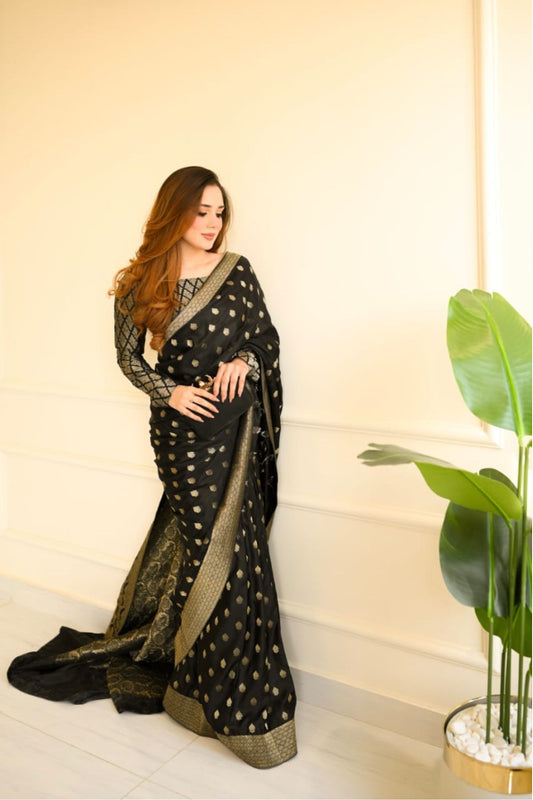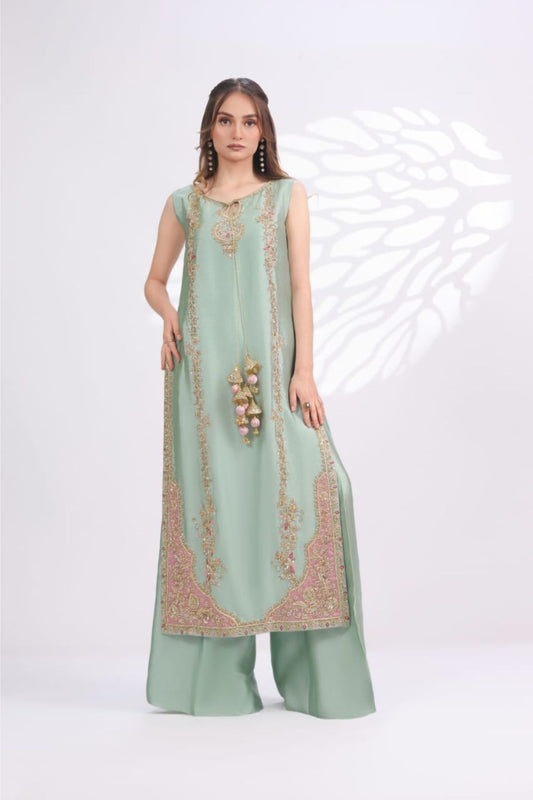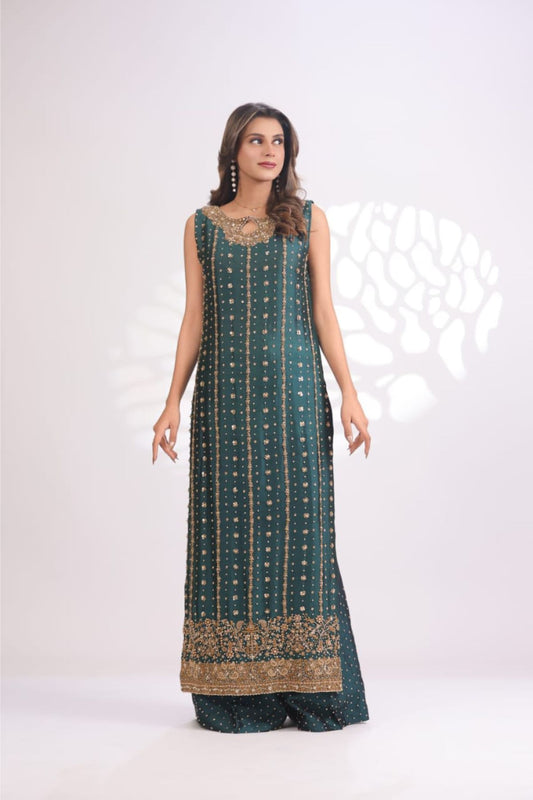The Importance of Choosing the Right Fabric for Your Wedding Dress
Introduction
Your wedding day is one of the most important days of your life, and your wedding dress plays a central role in making you feel like a true bride. One often-overlooked aspect of choosing the perfect wedding dress is selecting the right fabric. The fabric you choose can impact not only the overall look and style of your dress but also your comfort throughout the day. In this blog post, we'll delve into the significance of choosing the right fabric for your wedding dress.
Comfort Matters
Your wedding day is one of the most important and memorable days of your life, and feeling comfortable throughout the celebration is essential. Comfort isn't just about physical ease; it also impacts your confidence, enjoyment, and overall experience. Let's explore the significance of comfort on your wedding day, particularly focusing on how fabric choice can affect your comfort level and why breathable and lightweight fabrics for your wedding wear are ideal.
Importance of Comfort on Your Wedding Day:
-
Confidence: Feeling comfortable in your wedding attire directly contributes to your confidence. When you're at ease, you can carry yourself with grace and poise, making you shine even brighter as the center of attention.
-
Enjoyment: Weddings can be long and eventful, involving various activities and rituals. Being comfortable allows you to fully enjoy each moment, from the ceremony to the reception and everything in between.
-
Mobility: Weddings often involve dancing, walking, and standing for extended periods. Comfortable attire ensures that you can move freely and participate in all the festivities without restriction.
-
Mental Focus: Physical discomfort can be distracting, taking your attention away from the most important aspects of your day, such as your vows and the presence of loved ones. Comfortable attire allows you to stay mentally focused and present.

Fabric Choice and Comfort:
The choice of fabric for your wedding dress plays a significant role in your comfort. Here's how different fabrics can affect your overall comfort level:
-
Silk: While silk is luxurious and elegant, it may not be the most breathable option. It's excellent for cooler indoor weddings but can be less comfortable in hot and humid outdoor settings.
-
Chiffon: Chiffon is a lightweight, sheer fabric known for its breathability. It allows air circulation, making it suitable for outdoor weddings, especially during the warm seasons.
-
Georgette: Georgette is another breathable fabric that offers comfort and ease of movement. It's a great choice for outdoor weddings where you want to stay cool and comfortable.
-
Organza: Organza, like chiffon and georgette, is lightweight and breathable. It's perfect for creating a romantic, flowing look while keeping you comfortable.
-
Cotton: For casual outdoor weddings, cotton can be an excellent choice. It's highly breathable, making it comfortable for both the bride and the groom.
Breathable and Lightweight Fabrics for Outdoor Weddings:
Outdoor weddings often come with unique challenges, such as varying weather conditions and the need for mobility. Here are some breathable and lightweight fabric options that are ideal for outdoor weddings:
-
Chiffon: This airy fabric drapes beautifully and is perfect for wedding dresses, especially for warm-weather outdoor ceremonies.
-
Georgette: With its flowing and lightweight nature, georgette is a comfortable choice for brides who want an elegant yet breathable option.
-
Tulle: Tulle is a versatile fabric that's both lightweight and breathable. It's commonly used for creating dreamy, ethereal bridal looks.
-
Linen: For a rustic outdoor wedding, linen can be an excellent choice for both bride and groom attire. It's highly breathable and comfortable in warm weather.
-
Cotton Blends: Blended fabrics that incorporate cotton are comfortable and breathable, making them suitable for various outdoor wedding styles.
Flattering Your Body Type
When it comes to dressing to flatter your body type, the choice of fabric plays a crucial role in enhancing your best features and achieving a balanced silhouette. Different fabrics have distinct properties that can either emphasize or downplay certain aspects of your body shape. In this guide, we will explore how specific fabrics can complement various body types, provide examples of fabrics that work well for each type, and offer tips on accentuating your best features through smart fabric choices.

Hourglass Shape:
- Fabrics to Consider: For those with an hourglass figure (balanced bust and hips with a well-defined waist), fabrics that drape and gently hug your curves are ideal. Think silk, jersey, and stretchy blends.
- Accentuate Your Best Features: Emphasize your small waist by choosing fabrics that naturally cinch at the waist, like jersey or a silk wrap dress.
Pear Shape:
- Fabrics to Consider: Pear-shaped individuals typically have narrower shoulders and a fuller lower body. Opt for fabrics like A-line dresses in flowing materials such as chiffon, georgette, and silk.
- Accentuate Your Best Features: Choose fabrics that glide over your hips and thighs, drawing attention to your upper body and creating a balanced look.
Apple Shape:
- Fabrics to Consider: Apple-shaped body types often carry weight around the midsection. Look for fabrics with structure like denim, twill, or thick knits that provide support and create a smoother appearance.
- Accentuate Your Best Features: Select fabrics that offer a bit of stretch for comfort while providing structure to streamline your torso.
Rectangle Shape:
- Fabrics to Consider: For those with a rectangular body shape (where the bust, waist, and hips are nearly the same width), opt for fabrics that add curves and definition, such as layered tulle, lace, or ruffled materials.
- Accentuate Your Best Features: Choose fabrics with texture or ruching to create the illusion of curves, particularly around the bust and hips.
Inverted Triangle Shape:
- Fabrics to Consider: Individuals with broad shoulders and a narrower lower body should focus on soft and flowing fabrics like chiffon, silk, and organza to balance their proportions.
- Accentuate Your Best Features: Choose fabrics that create movement and softness around the hips and legs to draw attention away from the shoulders.
Full-Figured/Plus Size:
- Fabrics to Consider: Plus-size individuals can benefit from fabrics that provide structure and support while maintaining comfort. Fabrics like ponte knit, scuba, or stretch crepe are great choices.
- Accentuate Your Best Features: Look for fabrics with a bit of stretch to create a smooth silhouette and avoid fabrics that cling too tightly.
Petite Body Type:
- Fabrics to Consider: For those with a petite frame, lightweight and airy fabrics like chiffon, georgette, or silk can add elegance without overwhelming your stature.
- Accentuate Your Best Features: Opt for fabrics that create vertical lines to elongate your silhouette, such as vertical stripes or fine pleats.
In conclusion, understanding your body type and selecting the right fabrics can help you make the most of your unique features and create a flattering, balanced look. Whether you're accentuating curves, adding definition, or elongating your silhouette, the right fabric choice can make a significant difference in how you feel and look in your clothing. Experiment with different fabrics and styles to find what works best for your body type and personal style.
Enhancing the Silhouette
The choice of fabric is a pivotal factor in determining the overall silhouette of a dress. Whether you're aiming for a fitted and structured look or a soft and romantic appearance, the type of fabric you select will significantly impact the way your dress drapes, molds, and flows around your body. In this discussion, we'll explore how different fabrics influence the dress silhouette, with a focus on structured fabrics for a fitted look and flowy fabrics for a softer, romantic effect.

Structured Fabrics for a Fitted Look:
Structured fabrics are designed to hold their shape and provide a more tailored appearance. Here's how they contribute to creating a fitted silhouette:
-
Support and Control: Fabrics like satin, taffeta, brocade, and denim offer excellent support and control over the body's contours. They can help define the waistline and create a more sculpted appearance.
-
Emphasizing Curves: Structured fabrics can accentuate curves by providing a firm foundation that follows the natural lines of the body. This is particularly effective for hourglass or pear-shaped figures.
-
Clean Lines and Sharp Edges: These fabrics often have crisp and clean lines, making them suitable for structured bodices, tailored skirts, and structured elements like pleats or folds.
-
Shape Retention: Structured fabrics maintain their shape and do not easily wrinkle or crease, ensuring that your dress looks polished and fitted throughout the day.
Flowy Fabrics for a Soft, Romantic Appearance:
Flowy fabrics, on the other hand, create a more relaxed and ethereal silhouette, which is perfect for achieving a soft and romantic look:
-
Gentle Draping: Fabrics like chiffon, georgette, silk, and organza are known for their graceful, gentle drape. They flow loosely over the body, creating an airy, dreamy effect.
-
Fluid Movement: Flowy fabrics allow for natural and fluid movement, making them ideal for dresses with flowing skirts, capes, or layered details.
-
Aesthetic Softness: These fabrics lend a soft and romantic aesthetic to your dress, making them popular choices for wedding gowns, evening dresses, and bohemian-inspired designs.
-
Comfort and Breathability: Flowy fabrics are often lightweight and breathable, ensuring comfort throughout extended wear, especially in warm weather.
-
Camouflaging Imperfections: The soft, flowing nature of these fabrics can help conceal certain imperfections or areas of concern, providing a forgiving and flattering look.
The Season and Venue
Selecting the right fabric for your wedding dress is not just about aesthetics but also practicality. Your wedding date and venue play a pivotal role in determining which fabrics will keep you comfortable and stylish throughout your special day. Let's explore how the season and venue should inform your fabric choice, along with recommendations for different seasons and insights into indoor and outdoor weddings.
Summer Wedding (Hot Weather):
- Recommended Fabrics: Lightweight and breathable fabrics like chiffon, georgette, organza, and lightweight silk are excellent choices. They allow for proper ventilation and help you stay cool and comfortable under the sun.
- Why: In summer, you'll want a fabric that won't trap heat, ensuring you remain cool and fresh during the festivities.
Winter Wedding (Cold Weather):
- Recommended Fabrics: Heavier materials such as velvet, satin, brocade, or wool blends are ideal for winter weddings. Consider dresses with a lining for extra warmth.
- Why: Winter fabrics provide insulation and warmth, keeping you cozy as you celebrate your big day in cooler temperatures.
Spring and Fall Weddings (Transitional Seasons):
- Recommended Fabrics: You have more flexibility during these seasons. Opt for medium-weight fabrics like silk, taffeta, or crepe. Consider layers or bolero jackets that can be added or removed as needed.
- Why: Transitional season weddings allow for a wider range of fabric choices, combining comfort with style.
Venue Considerations

Indoor Wedding:
- Recommended Fabrics: Indoor venues are often climate-controlled, so you have more flexibility. Choose fabrics based on your personal style and comfort, whether it's luxurious silk, romantic lace, or structured satin.
- Why: With a controlled environment, you can focus on the aesthetics of your dress without being overly concerned about weather conditions.
Outdoor Wedding:
- Recommended Fabrics: For outdoor weddings, consider the venue's location and weather conditions. Lightweight fabrics like chiffon or organza are great for beach weddings, while a garden wedding might allow for more variety.
- Why: Outdoor venues can introduce elements like wind, sand, or grass, so lightweight and flowing fabrics are often favored to navigate these conditions comfortably.
Destination Wedding:
- Recommended Fabrics: Destination weddings often take place in unique settings. Consider the destination's climate and environment when choosing fabrics. For a tropical destination, lightweight and breathable fabrics are essential, while a winter wonderland wedding may require heavier materials.
- Why: Destination weddings combine the challenges of outdoor venues with the specific climate considerations of the chosen location. Flexibility is key to ensuring comfort and style.
Budget Considerations
Selecting the right fabric for your wedding dress can significantly influence the overall cost. While luxurious fabrics can elevate the dress, they often come with a higher price tag. Here, we'll explore how fabric choice affects the cost of your wedding dress, provide suggestions for finding quality fabrics within your budget, and discuss whether splurging on fabric is worth it for some brides.
How Fabric Choice Affects Cost:
-
Luxury Fabrics vs. Budget-Friendly Options: Luxury fabrics like silk satin, Chantilly lace, and hand-embroidered fabrics are known for their elegance but tend to be more expensive. Budget-friendly alternatives include synthetic blends, polyester satin, and lace imitations, which can mimic the look of premium fabrics at a fraction of the cost.
-
Amount of Fabric Needed: Some designs, such as ball gowns or dresses with long trains, require more fabric than simpler, sheath-style dresses. This can significantly impact the cost.
-
Customization and Embellishments: Extensive customizations, intricate embroidery, and beadwork will add to the overall cost of your dress, regardless of the fabric chosen.
Suggestions for Finding Quality Fabrics within Your Budget:
-
Consider Blended Fabrics: Look for blends that combine natural and synthetic fibers. For example, a silk-polyester blend can provide the luxurious feel of silk at a lower cost.
-
Explore Off-the-Rack Dresses: Bridal boutiques and off-the-rack wedding dress stores often carry dresses made from quality fabrics at a lower price compared to custom-made gowns.
-
Buy Sample Dresses: Bridal shops may sell sample dresses used for trying on. These dresses are typically in excellent condition and sold at a discount.
-
Online Retailers: Some online retailers offer a wide range of wedding dresses at competitive prices. However, be cautious and research thoroughly before making a purchase.
-
Consider Secondhand or Vintage Dresses: Vintage shops and online marketplaces often have beautiful, pre-owned wedding dresses made from quality fabrics that can be altered to fit you perfectly.
Is Splurging on Fabric Worth It?
Whether or not splurging on fabric is worth it depends on your priorities, budget, and personal preferences:
-
Worth It for Some Brides: If the fabric is essential to you and you prioritize the texture, feel, and drape of your dress, splurging on a high-quality fabric may be worthwhile.
-
Considerations: Keep in mind that the overall impact of your dress goes beyond fabric alone. Elements like design, fit, and craftsmanship also contribute to its beauty. Balance your budget to ensure that all aspects align with your vision.
-
Budget Constraints: If you have a strict budget, you can still find stunning dresses made from budget-friendly fabrics that make you feel like a bride without breaking the bank. The key is to prioritize the elements that matter most to you.
Conclusion
Selecting the right fabric for your wedding dress is a decision that should be made carefully, considering factors such as comfort, style, season, and personal preferences. By choosing wisely, you can ensure that your wedding dress not only looks stunning but also makes you feel confident and comfortable on your special day. So, take your time, explore different fabric options, and make a choice that reflects your unique style and enhances your wedding day experience.






